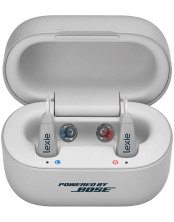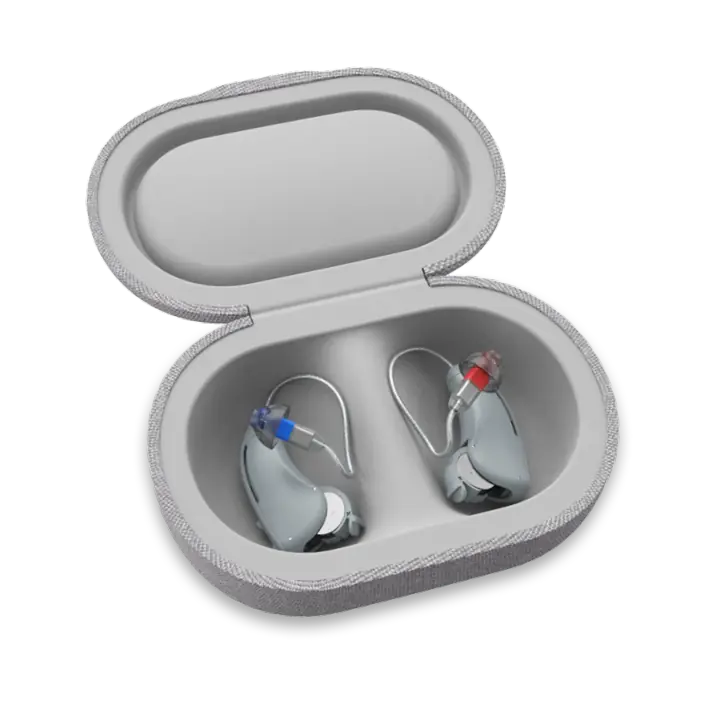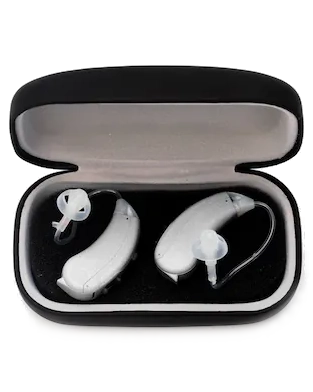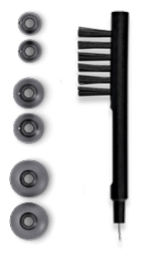What is an Open Fit Hearing Aid?
Published: October 4, 2021
Updated: July 22, 2022
Hearing aids come in a variety of different types, suited specifically for the type of hearing loss and the individual’s needs. There is one particular type of hearing aid that has become quite popular, and which is also being accepted by many hearing aid users – the open fit hearing aid. As the name represents, it is a hearing aid that has a slim tube that fits into the ear, without completely blocking the outside part of the ear and a dome that secures the slim tube in the ear canal. The tube connects to the hearing aid which sits behind the ear.
The mechanism of an open fit hearing aid is the hearing aid receives sound via a microphone; the microphone changes the sound waves into electrical signals and then sends these signals to an amplifier. The amplifier then makes the signals louder and sends them to the ear via the slim tube which acts as the receiver. This type of hearing aid has been designed for a specific type of hearing loss, those who have mild to moderate high-frequency hearing loss. The low frequencies enter the ear without being amplified, therefore making sounds more natural to the user and providing less feedback.
Open fit hearing aids come with different sizes of slim tubes and different types of domes. The slim tube is the part that connects the hearing aid to the ear and is visible to others. Everyone’s ear lengths are different; therefore one would need a specific length of a slim tube to fit your ear. Your hearing healthcare professional will be equipped with a sizing guide that will be used to measure your ear and fit the correct length of a slim tube.
The dome is the part that goes deep into the ear canal. The types of domes fitted will depend on the size and twists of your ear canal, as well as the type of hearing loss you present with and how much amplification is needed. Dome types are important as they will determine the type of sound quality you receive, so always consult with your hearing healthcare professional for the best advice.
The types of domes include:
- Open domes: used for high-frequency hearing loss where the lower frequencies are within the normal/mild hearing range and do not give the user an occluded feeling in the ear.
- Closed domes: similar to open domes, but they are used for a more severe hearing loss.
- Power domes: used for people with moderate to severe hearing loss, however, they provide a more occluded effect.
- Plus/Tulip domes: used for more severe hearing loss, but reduces the feedback coming from the hearing aid.
There are a few differences and similarities between the more common behind-the-ear hearing aid and the open fit hearing aid, these include but are not limited to:
- Both devices have the hearing aid situated behind the ear
- Both devices have a plastic piece that connects the hearing aid to the earmold or the tube in the canal
- Both devices have the same mechanism i.e. the microphone, amplifier, and speaker
- The behind-the-ear hearing aid has an earmold that goes into the ear canal, whereas the open fit hearing aid has a slim tube and a dome that fits into the ear canal
Some advantages of the open fit hearing aid include:
- The design of the tube allows the ear to stay ventilated
- The device is less noticeable, therefore better for aesthetic purposes for persons who are self-conscious of using a hearing aid
- The open fit hearing aid is more comfortable as one does not have the blocked feeling in the ear canal with an ear mold, only a thin tube is present in the ear canal
- Internal sounds such as chewing and coughing are not amplified, therefore making the hearing experience more comfortable to the user
- Individuals who experience wax build-up in the ear will benefit from an open fit hearing aid as there is more ventilation
- There is less feedback present with an open fit hearing aid, which many hearing aid users struggle with
- The slim tubes and domes are not expensive to replace once they are worn out or broken
- The open fit hearing aid can be fitted immediately without waiting for an ear mold to be taken specifically for your ear; therefore it cuts down the waiting time and multiple visits to your hearing healthcare professional. Furthermore, as your ear grows you will need new ear molds, but this is not the case with open-fit hearing aids as the tubes can be easily replaced by yourself.
Some disadvantages of the open fit hearing aid include:
- The hearing aid does not accommodate for all types of hearing loss, only mild to moderate high-frequency losses. If the hearing aid is fitted for patients with severe or profound hearing loss, there might be feedback present.
- The hearing aid is small and could be difficult to manage for people with dexterity issues, specifically the older population.
- The open fit hearing aid is smaller in size, so it uses smaller batteries and the batteries may need to be changed more regularly.
Individuals with hearing loss have specific needs, and the variety of hearing aids present on the market will be able to accommodate these needs. You need to be comfortable with your hearing aid and happy to use them, it’s best to consult with your nearest hearing healthcare professional to see if the open-fit hearing aid will suit your needs.
Lexie hearing aids
Lexie Hearing offers a variety of hearing aids at a price you can afford. Are you curious to find out if Lexie hearing aids are right for you? Visit the Lexie Hearing website to find out everything you need to know about Lexie.






